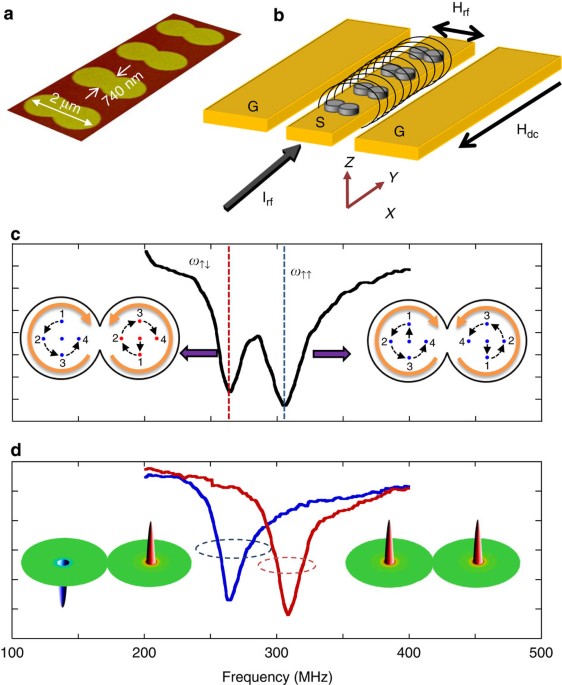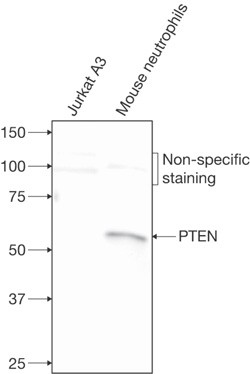
- Select a language for the TTS:
- UK English Female
- UK English Male
- US English Female
- US English Male
- Australian Female
- Australian Male
- Language selected: (auto detect) - EN
Play all audios:
ABSTRACT A spin vortex consists of an in-plane curling magnetization and a small core region (~10 nm) with out-of-plane magnetization. An oscillating field or current induce gyrotropic
precession of the spin vortex. Dipole–dipole and exchange coupling between the interacting vortices may lead to excitation of collective modes whose frequencies depend on the core
polarities. Here we demonstrate an effective method for controlling the relative core polarities in a model system of overlapping Ni80Fe20 dots. This is achieved by driving the system to a
chaotic regime of continuous core reversals and subsequently relaxing the cores to steady-state motion. It is shown that any particular core polarity combination (and therefore the spectral
response of the entire system) can be deterministically preselected by tuning the excitation frequency or external magnetic field. We anticipate that this work would benefit the future
development of magnonic crystals, spin–torque oscillators, magnetic storage and logic elements. You have full access to this article via your institution. Download PDF SIMILAR CONTENT BEING
VIEWED BY OTHERS ADVANCES IN COHERENT MAGNONICS Article 14 July 2021 ULTRASTRONG MAGNON-MAGNON COUPLING AND CHIRAL SPIN-TEXTURE CONTROL IN A DIPOLAR 3D MULTILAYERED ARTIFICIAL SPIN-VORTEX
ICE Article Open access 14 May 2024 CANTED SPIN ORDER AS A PLATFORM FOR ULTRAFAST CONVERSION OF MAGNONS Article Open access 29 May 2024 INTRODUCTION Vortices are observed in the statics and
dynamics of a variety of physical systems, such as fluids and plasma1, optics2, superconductors3 and magnetic materials4. In patterned mesoscopic ferromagnets, the ground state of the static
magnetization can have a form of a vortex that consists of a large region of in-plane curling magnetization (clockwise or anticlockwise sense of rotation or chirality) and a small core
region (~10 nm) with out-of-plane magnetization, which can be pointing either up (+1) or down (−1) (positive or negative core polarity _p_). When the vortex core is perturbed from its
equilibrium state by an in-plane oscillating field or current, it begins a rotational (gyrotropic) oscillation with a characteristic eigenfrequency in the subgigahertz range5,6,7. In a
magnetic dot that has a single vortex-state, the eigenfrequency of the gyrotropic oscillations of the vortex core for both directions of the core polarity (_p_=±1) is the same. By contrast,
in an array of coupled elements, the dynamic dipolar interaction eliminates this frequency degeneracy and results in collective gyrotropic excitations with different eigenfrequencies that
depend on both the relative polarities and chiralities of the individual vortices8,9,10,11. An array of interacting magnetic dots form a vortex magnonic crystal12,13, similar to the case of
coupled, uniformly magnetized elements14,15. The system can have a dynamically reconfigurable ground state characterized by different relative polarities and chiralities of the individual
dots; and it can have a corresponding dynamically controlled spectrum of collective excitation modes that determine the microwave absorption of the crystal. The development of effective
methods for dynamic control of the ground state in vortex-type magnonic crystals is fundamentally interesting and could also be important for possible microwave applications. Vortex
chirality has been controlled in confined geometries using various techniques16,17. Manipulation of the vortex core polarity has been shown in individual elements by resonant in-plane18,19
and perpendicular magnetic fields20, rotating magnetic fields21, pulsed currents22 and spin-polarized currents23. However, control of the vortex core polarities in interacting vortex-state
magnetic dots remains a challenge. In this work, we demonstrate an effective method for controlling the relative vortex core polarities in a model system of connected (slightly overlapping)
vortex-state permalloy (Ni80Fe20) magnetic dots. This method also permits the effective selection of a specific dynamic mode of microwave absorption. We utilize the geometry of connected
double-dot structures because they have the potential to form building blocks of vortex magnonic crystals12,13. An advantage of the double-dot overlap structure is the strong dynamic
interaction between the vortex cores and, consequently, the large difference between the eigenfrequencies of the gyrotropic dynamic modes that correspond to the same and opposite
orientations of the interacting cores. In the remanent state of this structure, the configurations with the same (_p_1_p_2=+1) or opposite (_p_1_p_2=−1) core polarities are equally probable.
Therefore, the selection of a particular dynamic mode in this system is achieved by first driving the system into a chaotic regime of continuous vortex core reversals via a large-amplitude
external driving signal that has the same frequency as one of the dynamic gyrotropic modes of the system. Then, the driving amplitude is reduced so that the system relaxes to the state
corresponding to the other collective gyrotropic mode that has a different eigenfrequency; therefore, the system can no longer resonantly absorb energy from the driving signal. RESULTS
SAMPLE STRUCTURE AND MEASUREMENT SETUP Permalloy (Ni80Fe20) double-dot structures with dimensions of 2 × 1 × 0.048 μm3 and vertical contact length of 740 nm were fabricated on top of shorted
coplanar waveguide (CPW). Representative atomic force microscopy image for a dot pair is shown in Fig. 1a. The signal line of the CPW consists of >1,000 of such dot-pairs. Microwave
measurements were performed in reflection mode using a vector network analyser as the current source. Figure 1b shows the schematic of the CPW, where the radio frequency (RF) field is
applied along the long axis of the system (_x_ axis). The absorption spectrum for the as-grown sample at remanence for −15 dBm of input microwave power (_P_Low) is shown in Fig. 1c. This
system of two vortex cores has an equal probability of having either of the two polarization combinations24. The two absorption peaks in Fig. 1c correspond to opposite (_p_1_p_2=−1) and same
(_p_1_p_2=+1) polarity combinations. It should be noted that the measured spectra is the response from >1,000 dot pairs on the waveguide. As the structures are fabricated using
electron-beam lithography technique, we believe that the effect of size variation on the resonant frequencies of the coupled modes is within the line-width of each excited mode. The
eigenfrequencies for the two polarity combinations are 265 MHz (_ω_↑↓) and 305 MHz (_ω_↑↑), respectively. This spectrum is similar to the response from an array of elliptical particles24.
The structure of the collective gyrotropic modes follows from the symmetry of the double-dot system (Supplementary Fig. S2). For the _p_1_p_2=−1 state, the two vortex cores gyrate
out-of-phase with each other along the direction of RF excitation (_x_-axis) and in-phase in the orthogonal direction (_y_-axis). However, for the _p_1_p_2=+1 state, the two cores gyrate
in-phase for both directions, as schematically illustrated in Fig. 1c. Because the chiralities of the two vortices in a double-dot system are always opposite to each other, the _p_1_p_2=−1
mode is linearly polarized (the net magnetic moment oscillates along _x_-axis), whereas the polarization of the _p_1_p_2=+1 mode is elliptical (the net oscillating magnetic moment has both
_x_ and _y_ components). DEMONSTRATION OF POLARITY CONTROL To explore the phenomenon of vortex core reversal in coupled vortices, the double-dot structures were driven at a high microwave
power of 10 dBm (_P_High) at the resonance frequency of one of the collective modes. When the power was subsequently reduced to a minimum accessible value of _P_Low, which was used to probe
vortex excitations in the linear regime, only one absorption peak that corresponded to the second collective mode was observed in the frequency spectrum. This result indicates that when the
system is excited by a large-amplitude signal at the frequency of _ω_↑↓, with the reduction of the driving amplitude, the system relaxes to the ground state of core polarities that
correspond to the collective mode with the frequency of _ω_↑↑ and vice versa. The representative absorption spectra for two different excitation frequencies of _ω_↑↓ (red curve) and _ω_↑↑
(blue curve) are shown in Fig. 1d. Indeed, only one absorption peak, corresponding to the collective mode that is non-resonant with the frequency of the driving signal, is present in each
low-amplitude spectrum of the system. In the following, the excitation process of the vortex core motion with a large-amplitude external signal _P_High and the subsequent reduction of the
signal amplitude to _P_Low at a constant driving frequency corresponding to one of the collective modes will be termed as the initialization procedure. The absorption spectra obtained after
this procedure will be measured at _P_Low to identify the dynamic collective modes (corresponding to a particular combination of vortex polarities) present in the system. MICROMAGNETIC
MODELLING To simulate the experimental results, the gyrotropic motion of the vortex cores in the two dots were excited at a high RF amplitude of 52 Oe (sufficiently strong to induce the
vortex core reversal), which was then gradually reduced to 2 Oe in steps of 0.1 Oe per cycle. Figure 2 shows the time evolution of the average magnetization when the system was excited at
_ω_↑↑ (Fig. 2a) and _ω_↑↓ (Fig. 2b). The initial combination of the vortex core polarities can be chosen either parallel or antiparallel. One can easily observe that at sufficiently high RF
fields, the two vortex cores undergo continuous reversals, as seen from the chaotic and unsynchronized oscillations of magnetization. However, below a certain RF field, both the _x_ and _y_
components of the dot magnetization stabilize to steady-state oscillations corresponding to a polarity combination of the non-resonant mode. Importantly, this reveals that the resultant
state of the system does not depend on the input ground state of vortex core polarities; it only depends on the initialization frequency. Therefore, the final configuration of the system is
completely decoupled from the driving signal and cannot absorb energy from this signal. The transition from chaotic to synchronized vortex core motion, marked as the shadow region in Fig.
2a, is of particular interest. This region (shadow area in Fig. 2b) is presented in Fig. 3a. It has been established that the dynamically-driven core reversal is mediated by a series of
complex processes: nucleation of a transient vortex–antivortex pair followed by the annihilation of the original vortex with the newly formed antivortex18,23. Apart from the critical
velocity and critical radius defining the criteria for the core reversal, a well-defined threshold value of the exchange energy is also necessary for this process25. Therefore, to quantify
the core reversal occurring in the interacting vortices, the exchange energy of the coupled system was considered and the graph of this energy is shown in Fig. 3a. Each peak in the exchange
energy is associated with a vortex core reversal. Because the average magnetization response (_M__X_ and _M__Y_) does not directly provide information about the core reversals in each dot,
the magnetization components of each dot were separately deduced from the simulations. These components are shown in Fig. 3b, respectively. Surprisingly, we observed that in a particular
period of time, only one core in the double-disk system undergoes reversal, whereas the other one performs a steady-state rotational motion. This result is surprising because the system is
continuously driven using high oscillating fields and only one core undergoes several reversal processes. For instance, from _t_1=2–38 ns, the core in dot 2 undergoes continuous core
reversals, whereas the core in dot 1 rotates with the same frequency as the driving frequency. The vortex core trajectories for this time span are shown in Fig. 3d. After ~38 ns, there is a
transfer of energy between the cores, and the core in dot 1 begins to reverse. The respective core trajectories for this state are shown in Fig. 3e. The dot whose vortex core undergoes
reversal is indicated by grey regions in Fig. 3b. This behaviour is remarkable because it demonstrates that a systematic reversal pattern exists even in a quasi-chaotic reversal regime (to
investigate this phenomenon, an analytical approach was utilized; the detailed description of this approach is provided in Supplementary Discussion). It was observed that the relative phase
difference between the two coupled modes determines the particular core that undergoes reversals. The dynamics induced due to this reversal process forces the phase difference to change its
sign and consequently, the second core begins to reverse. This transfer process continues until the excitation amplitude is reduced. A particular core continues to reverse for a
characteristic time _T_ that is on the order of the inverse of the mode frequency difference, _T_~1/Δ_ω_. An energy transfer mechanism was previously observed in separated dots by Jung _et
al._,9 where the ground state of only one of the dots was perturbed by a pulsed RF field. This ground-state perturbation introduced an asymmetry in the initial conditions and, hence, the
system behaved like coupled harmonic oscillators where the magnetic potential energy of a vortex core was transferred from one dot to the other. Therefore, the transfer of the vortex
potential energy observed in our case for the chaotic regime (as opposed to the linear regime) is unique. When the amplitude of the driving signal is reduced, the number of vortex core
reversal events decreases and the rotation of both vortex cores eventually become steady without any further reversals (pink region in Fig. 3b). For the simulated responses shown in Fig. 3,
the structure was excited at a fixed driving frequency of 530 MHz, which is the resonance frequency of the _p_1_p_2=−1 mode. Therefore, for this driving frequency, the ground state with
opposite polarities of the interacting vortex cores is more susceptible to the core reversal. By contrast, for the ground state with the same polarities of the vortex cores (and having a
different eigenfrequency), a substantially larger driving amplitude is required to induce the vortex core reversal. This resonance asymmetry is responsible for our ability to select a
particular dynamic collective mode (and a corresponding particular configuration of the vortex core polarities). As a result of the initialization process described above, after passing
through a quasi-chaotic regime of continuous core reversals followed by a subsequent decrease of the driving amplitude, the system settles into a regime of steady-state vortex gyration with
the mode whose eigenfrequency is non-resonant with the driving frequency. RF POWER DEPENDENCE ON POLARITY CONTROL In the experiments we applied a fixed high-amplitude driving signal of
_P_High to induce the vortex core reversals. At the same time, the simulation results clearly indicate that there is a certain threshold in the driving power, below which the mode selection
procedure does not work. To experimentally verify this, we subjected our double-dot samples to different amplitudes of driving fields. The experimentally measured colour-coded frequency
spectra of the system subjected to the driving frequencies of _ω_↑↓=265 MHz and _ω_↑↑=305 MHz are summarized in Fig. 4a, respectively. To obtain these spectra, we varied the value of _P_high
during the initialization process at fixed excitation frequencies of 265 and 305 MHz. Low-power frequency scans were then performed to identify the collective modes present in the system.
The horizontal dotted lines indicate the critical driving amplitudes above which one of the collective modes in the system completely disappears. For example, in Fig. 4a, where the driving
frequency is _ω_↑↓=265 MHz, a driving power of <−2 dBm is not sufficient to induce vortex core reversals and, consequently, both absorption peaks are present in the spectrum. However, for
driving powers >−2 dBm, the excitation amplitude is sufficiently strong to induce the core reversal process and, consequently, only one collective mode (not resonant with the driving) is
present. Figure 4b (where the driving frequency is _ω_↑↑=305 MHz) shows the same effect, but with a different collective mode as the resultant ground state. The difference in the critical
driving amplitudes (shown by dotted lines) for these two distinct cases is a direct measure of the strength of the dynamical interaction between the collective gyrotropic modes in our
double-dot sample. Thus, two collective gyrotropic modes with substantially different frequencies were observed in the two-vortex model system. Our experiment clearly demonstrated that the
final ground state of the system, which was achieved after the initialization process, is only dependent on the driving frequency and not on the initial ground state of the system (that is,
the initial combination of the vortex core polarities). The mode that is present at the end of the process is non-resonant with the driving field, and it is consequently completely decoupled
from the driving field. DEPENDENCE OF RESULTANT POLARITY COMBINATION ON EXTERNAL MAGNETIC FIELD The frequencies of collective modes are strongly dependent on the external magnetic field.
Consequently, varying the bias field can be used to tune the eigenfrequencies of the system. Thus, a particular collective mode can be coupled or decoupled to RF input signal of given
(fixed) frequency by varying the strength of the external field when applied along the _y_ axis of the system. This process is illustrated in Supplementary Fig. S1, where a particular
collective mode can be selected by choosing a proper field sweep range. On the basis of the universality of the mode selection phenomena, a phase diagram has been constructed with respect to
the excitation frequency and the external magnetic field, as shown in Fig. 4c. This experimental phase diagram for the connected double-dot structure specifically provides the desired
parameters for defining the ground state with either of the two polarity combinations. An external magnetic field can be swept horizontally on the phase diagram at a constant excitation
frequency and, depending on the direction of the sweep and on the stop field, a unified state can be set in the entire array. Similarly, the frequency can be swept vertically in the presence
of a constant magnetic field to obtain a specific ground state. DISCUSSION We developed a new and effective method to control the ground state determined by the relative vortex core
polarities and the dynamic excitation mode in a model system of coupled vortex-state magnetic dots. The method involves driving the system by a strong periodic driving field into a
quasi-chaotic regime of continuous vortex core reversals. This process is followed by a gradual reduction of the driving field and relaxing of the system to a ground state, which supports
the dynamical mode that is non-resonant with the driving frequency and is therefore non-responsive with the driving field. A similar approach can be used to dynamically select a particular
ground state in a vortex-state magnonic crystal12,13 and in other physical systems that have multiple stable ground states, such as arrays of coupled nano-oscillators26,27 or spin-ice-type
lattices28. Furthermore, we believe that the proposed approach to control the remanent state by exploring driven (non-linear) dynamics can be applied to non-magnetic systems that are
characterized by ground states. METHODS SAMPLE FABRICATION The samples were fabricated using electron-beam lithography and lift-off processes. The double-dot structure has dimensions of 2 ×
1 μm2 with vertical contact length of 740 nm and thickness 48 nm. The separation between each pair is 1 μm and, therefore, dipole–dipole interactions between dot pairs can be neglected. To
measure the resonance frequencies of the gyrotropic modes, the structures were fabricated on top of a shorted Cr (10 nm)/Au (300 nm) CPW with a 3-μm-wide signal line. MICROMAGNETIC
SIMULATIONS Micromagnetic simulations29 were performed using the standard Ni80Fe20 parameters; an exchange stiffness constant of _A_=13 pJ m−1, saturation magnetization Ms=8 × 105 A m−1,
gyromagnetic ratio _γ_=18.5 GHzper kOe, a dimensionless Gilbert constant _α_=0.01, cell size of 5 × 5 × 5 nm3 and magnetocrystalline anisotropy was neglected. To avoid large computational
times, the structural dimensions were reduced by half to 1 × 0.5 μm2 rather than 2 × 1 μm2. The resonance frequencies of the system are obtained by sweeping the driving frequency from 300 to
900 MHz with a constant RF field amplitude of 1 Oe. The representative time evolution of the two magnetization components for both the polarity combinations (_p_1_p_2=±1) are presented in
Supplementary Fig. S2. The calculated eigenfrequencies of the two modes are 530 (_p_1_p_2=−1) and 580 MHz (_p_1_p_2=+1). Qualitative analysis of the collective vortex modes was also
performed. The details of this analysis are provided in Supplementary Methods. ADDITIONAL INFORMATION HOW TO CITE THIS ARTICLE: Jain, S. _et al._ From chaos to selective ordering of vortex
cores in interacting mesomagnets. _Nat. Commun._ 3:1330 doi: 10.1038/ncomms2331 (2012). REFERENCES * Nardin G. et al. Hydrodynamic nucleation of quantized vortex pairs in a polariton quantum
fluid. _Nat. Phys._ 7, 635–641 (2011). Article CAS Google Scholar * Khaykovich L. et al. Formation of a matter-wave bright soliton. _Science_ 296, 1290–1293 (2002). Article ADS CAS
Google Scholar * Abrikosov A. A. On the magnetic properties of supercondictors of the second group. _J. Exptl. Theoret. Phys._ 32, 1442–1452 (1957). Google Scholar * Novosad V. et al.
Nucleation and annihilation of magnetic vortices in sub-micron permalloy dots. _IEEE Trans. Magn._ 37, 2088–2090 (2001). Article ADS CAS Google Scholar * Choe S.-B. et al. Vortex
core-driven magnetization dynamics. _Science_ 304, 420–422 (2004). Article ADS CAS Google Scholar * Novosad V. et al. Magnetic vortex resonance in patterned ferromagnetic dots. _Phys.
Rev. B_ 72, 024455 (2005). Article ADS Google Scholar * Guslienko K. et al. Eigenfrequencies of vortex state excitations in magnetic submicron-size disks. _J. Appl. Phys._ 91, 8037–8039
(2002). Article ADS CAS Google Scholar * Sugimoto S. et al. Dynamics of coupled vortices in a pair of ferromagnetic disks. _Phys. Rev. Lett._ 106, 197203 (2011). Article ADS Google
Scholar * Jung H. et al. Tunable negligible-loss energy transfer between dipolar-coupled magnetic disks by stimulated vortex gyration. _Sci. Reports_ 1, 59 (2011). Article CAS Google
Scholar * Vogel A., Drews A., Kamionka T., Bolte M. & Meier G. Influence of dipolar interaction on vortex dynamics in arrays of ferromagnetic disks. _Phys. Rev. Lett._ 105, 037201
(2010). Article ADS Google Scholar * Awad A. A. et al. Spin excitation frequencies in magnetostatically coupled arrays of vortex state circular permalloy dots. _Appl. Phys. Lett._ 97,
132501 (2010). Article ADS Google Scholar * Huber R. & Grundler D. Ferromagnetic nanodisks for magnonic crystals and waveguides. _Proc. SPIE_ 8100, 81000D (2011). Article ADS Google
Scholar * Shibata J. & Otani Y. Magnetic vortex dynamics in a two-dimensional square lattice of ferromagnetic nanodisks. _Phys. Rev. B_ 70, 012404 (2004). Article ADS Google Scholar
* Verba R., Melkov G., Tiberkevich V. & Slavin A. Collective spin-wave excitations in a two-dimensional array of coupled magnetic nanodots. _Phys. Rev. B_ 85, 014427 (2012). Article
ADS Google Scholar * Verba R., Melkov G., Tiberkevich V. & Slavin A. Fast switching of a ground state of a reconfigurable array of magnetic nano-dots. _Appl. Phys. Lett._ 100, 192412
(2012). Article ADS Google Scholar * Yakata S. et al. Chirality control of magnetic vortex in a square Py dot using current-induced Oersted field. _Appl. Phys. Lett._ 99, 242507 (2011).
Article ADS Google Scholar * Jaafar M. et al. Control of the chirality and polarity of magnetic vortices in triangular nanodots. _Phys. Rev. B_ 81, 05439 (2010). Google Scholar *
Waeyenberge B. et al. Magnetic vortex core reversal by excitation with short bursts of an alternating field. _Nature_ 444, 461–464 (2006). Article ADS Google Scholar * Pigeau B. et al.
Optimal control of vortex-core polarity by resonant microwave pulses. _Nat. Phys._ 7, 26–31 (2011). Article CAS Google Scholar * Kikuchi N. et al. Vertical bistable switching of spin
vortex in a circular magnetic dot. _J. Appl. Phys._ 90, 6548–6549 (2001). Article ADS CAS Google Scholar * Curcic M. et al. Magnetic vortex core reversal by rotating magnetic fields
generated on micrometer length scales. _Phys. Status Solidi B_ 248, 2317–2322 (2011). Article ADS CAS Google Scholar * Liu Y., Gliga S., Hertel R. & Schneider C. M. Current-induced
magnetic vortex core switching in a permalloy nanodisk. _Appl. Phys. Lett._ 91, 112501 (2007). Article ADS Google Scholar * Yamada K. et al. Electrical switching of the vortex core in a
magnetic disk. _Nat. Mater._ 6, 269–273 (2007). Article ADS CAS Google Scholar * Buchanan K. S. et al. Soliton-pair dynamics in patterned ferromagnetic ellipses. _Nat. Phys._ 1, 172–176
(2005). Article CAS Google Scholar * Gliga S., Liu Y. & Hertel R. Energy thresholds in the magnetic vortex core reversal. _J. Phys._ 303, 012005 (2011). Google Scholar * Dussaux A.
et al. Large microwave generation from current-driven magnetic vortex oscillators in magnetic tunnel junctions. _Nat. Commun._ 1, 8 (2010). Article CAS Google Scholar * Pribiag V. S. et
al. Magnetic vortex oscillator driven by d.c. spin-polarized current. _Nat. Phys._ 3, 498–503 (2007). Article CAS Google Scholar * Wang R. F. et al. Artificial spin ice in a geometrically
frustrated lattice of nanoscale ferromagnetic islands. _Nature_ 439, 303–306 (2006). Article ADS CAS Google Scholar * Donahue M. J. & Porter D. G. _OOMMF User’s guide, Version 1.0,
Interagency Report NIST IR 6376_ Gaithersburg, MD (1999). Download references ACKNOWLEDGEMENTS Work at Argonne and use of the Center for Nanoscale Materials was supported by the US
Department of Energy, Office of Science, Office of Basic Energy Sciences, under Contract No. DE-AC02-06CH11357. This work was in part supported by grant DMR-1015175 from the US National
Science Foundation, by a Contract from the US Army TARDEC and RDECOM, and by a grant from DARPA. AUTHOR INFORMATION AUTHORS AND AFFILIATIONS * Materials Science Division, Argonne National
Laboratory, Argonne, 60439, Illinois, USA S. Jain, V. Novosad, F.Y. Fradin, J.E. Pearson & S.D. Bader * Department of Physics, Oakland University, Rochester, 48309, Michigan, USA V.
Tiberkevich & A.N. Slavin * Center for Nanoscale Materials, Argonne National Laboratory, Argonne, 60439, Illinois, USA S.D. Bader Authors * S. Jain View author publications You can also
search for this author inPubMed Google Scholar * V. Novosad View author publications You can also search for this author inPubMed Google Scholar * F.Y. Fradin View author publications You
can also search for this author inPubMed Google Scholar * J.E. Pearson View author publications You can also search for this author inPubMed Google Scholar * V. Tiberkevich View author
publications You can also search for this author inPubMed Google Scholar * A.N. Slavin View author publications You can also search for this author inPubMed Google Scholar * S.D. Bader View
author publications You can also search for this author inPubMed Google Scholar CONTRIBUTIONS S.J. and V.N. conceived the idea, fabricated samples, performed experiments and micromagnetic
modelling. F.Y.F. and J.E.P. setup the measurement apparatus. F.Y.F. designed and modelled microwave properties of the waveguide structures. S.J. and J.E.P. deposited magnetic thin films.
A.S. and V.T. developed the analytical theory. S.J., V.N., F.Y.F, J.E.P., A.S., V.T. and S.D.B. discussed the results and wrote the text of the manuscript. CORRESPONDING AUTHOR
Correspondence to V. Novosad. ETHICS DECLARATIONS COMPETING INTERESTS The authors declare no competing financial interests. SUPPLEMENTARY INFORMATION SUPPLEMENTARY INFORMATION Supplementary
Figures S1 and S2, Supplementary Discussion and Supplementary Methods (PDF 340 kb) RIGHTS AND PERMISSIONS Reprints and permissions ABOUT THIS ARTICLE CITE THIS ARTICLE Jain, S., Novosad, V.,
Fradin, F. _et al._ From chaos to selective ordering of vortex cores in interacting mesomagnets. _Nat Commun_ 3, 1330 (2012). https://doi.org/10.1038/ncomms2331 Download citation *
Received: 18 September 2012 * Accepted: 26 November 2012 * Published: 27 December 2012 * DOI: https://doi.org/10.1038/ncomms2331 SHARE THIS ARTICLE Anyone you share the following link with
will be able to read this content: Get shareable link Sorry, a shareable link is not currently available for this article. Copy to clipboard Provided by the Springer Nature SharedIt
content-sharing initiative








